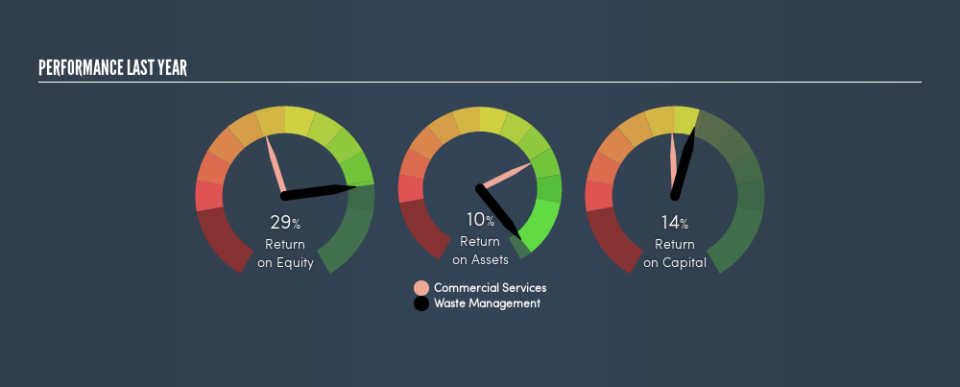A Close Look At Waste Management, Inc.’s (NYSE:WM) 14% ROCE

Want to participate in a short research study? Help shape the future of investing tools and you could win a $250 gift card!
Today we'll look at Waste Management, Inc. (NYSE:WM) and reflect on its potential as an investment. In particular, we'll consider its Return On Capital Employed (ROCE), as that can give us insight into how profitably the company is able to employ capital in its business.
First up, we'll look at what ROCE is and how we calculate it. Second, we'll look at its ROCE compared to similar companies. Then we'll determine how its current liabilities are affecting its ROCE.
What is Return On Capital Employed (ROCE)?
ROCE is a measure of a company's yearly pre-tax profit (its return), relative to the capital employed in the business. Generally speaking a higher ROCE is better. Ultimately, it is a useful but imperfect metric. Renowned investment researcher Michael Mauboussin has suggested that a high ROCE can indicate that 'one dollar invested in the company generates value of more than one dollar'.
So, How Do We Calculate ROCE?
The formula for calculating the return on capital employed is:
Return on Capital Employed = Earnings Before Interest and Tax (EBIT) ÷ (Total Assets - Current Liabilities)
Or for Waste Management:
0.14 = US$2.8b ÷ (US$23b - US$3.6b) (Based on the trailing twelve months to March 2019.)
So, Waste Management has an ROCE of 14%.
View our latest analysis for Waste Management
Does Waste Management Have A Good ROCE?
ROCE is commonly used for comparing the performance of similar businesses. Using our data, we find that Waste Management's ROCE is meaningfully better than the 11% average in the Commercial Services industry. We consider this a positive sign, because it suggests it uses capital more efficiently than similar companies. Separate from Waste Management's performance relative to its industry, its ROCE in absolute terms looks satisfactory, and it may be worth researching in more depth.
It is important to remember that ROCE shows past performance, and is not necessarily predictive. ROCE can be deceptive for cyclical businesses, as returns can look incredible in boom times, and terribly low in downturns. ROCE is, after all, simply a snap shot of a single year. Future performance is what matters, and you can see analyst predictions in our free report on analyst forecasts for the company.
Do Waste Management's Current Liabilities Skew Its ROCE?
Current liabilities include invoices, such as supplier payments, short-term debt, or a tax bill, that need to be paid within 12 months. Due to the way the ROCE equation works, having large bills due in the near term can make it look as though a company has less capital employed, and thus a higher ROCE than usual. To counteract this, we check if a company has high current liabilities, relative to its total assets.
Waste Management has total assets of US$23b and current liabilities of US$3.6b. Therefore its current liabilities are equivalent to approximately 15% of its total assets. Current liabilities are minimal, limiting the impact on ROCE.
The Bottom Line On Waste Management's ROCE
This is good to see, and with a sound ROCE, Waste Management could be worth a closer look. There might be better investments than Waste Management out there, but you will have to work hard to find them . These promising businesses with rapidly growing earnings might be right up your alley.
I will like Waste Management better if I see some big insider buys. While we wait, check out this free list of growing companies with considerable, recent, insider buying.
We aim to bring you long-term focused research analysis driven by fundamental data. Note that our analysis may not factor in the latest price-sensitive company announcements or qualitative material.
If you spot an error that warrants correction, please contact the editor at editorial-team@simplywallst.com. This article by Simply Wall St is general in nature. It does not constitute a recommendation to buy or sell any stock, and does not take account of your objectives, or your financial situation. Simply Wall St has no position in the stocks mentioned. Thank you for reading.

 Yahoo Finance
Yahoo Finance 
